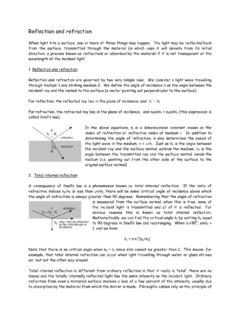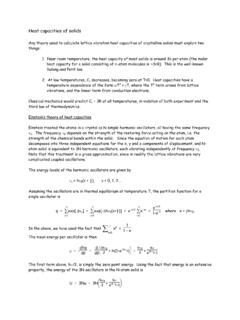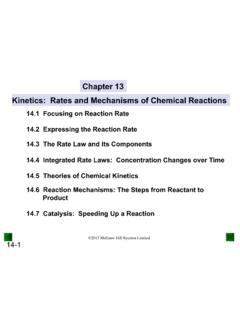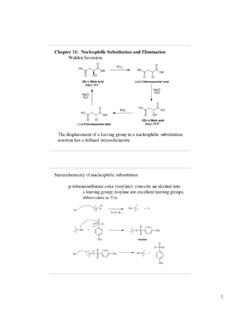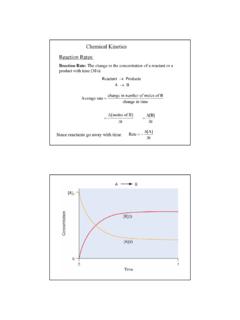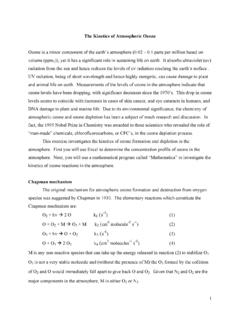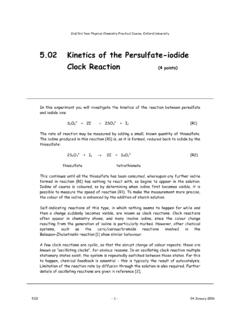Transcription of Reaction Kinetics - University of Oxford
1 1. Reaction Kinetics Dr Claire Vallance First year, Hilary term Suggested Reading Physical Chemistry, P. W. Atkins Reaction Kinetics , M. J. Pilling and P. W. Seakins Chemical Kinetics , K. J. Laidler Modern Liquid Phase Kinetics , B. G. Cox Course synopsis 1. Introduction 2. Rate of Reaction 3. Rate laws 4. The units of the rate constant 5. Integrated rate laws 6. Half lives 7. Determining the rate law from experimental data (i) Isolation method (ii) Differential methods (iii) Integral methods (iv) Half lives 8. Experimental techniques (i) Techniques for mixing the reactants and initiating Reaction (ii) Techniques for monitoring concentrations as a function of time (iii) Temperature control and measurement 9.
2 Complex reactions 10. Consecutive reactions 11. Pre-equilibria 12. The steady state approximation 13. Unimolecular' reactions the Lindemann-Hinshelwood mechanism 14. Third order reactions 15. Enzyme reactions the Michaelis-Menten mechanism 16. Chain reactions 17. Linear chain reactions The hydrogen bromine Reaction The hydrogen chlorine Reaction The hydrogen-iodine Reaction Comparison of the hydrogen-halogen reactions 18. Explosions and branched chain reactions The hydrogen oxygen Reaction 19. Temperature dependence of Reaction rates The Arrhenius equation and activation energies Overall activation energies for complex reactions Catalysis 20.
3 Simple collision theory 2. 1. Introduction Chemical Reaction Kinetics deals with the rates of chemical processes. Any chemical process may be broken down into a sequence of one or more single-step processes known either as elementary processes, elementary reactions , or elementary steps. Elementary reactions usually involve either a single reactive collision between two molecules, which we refer to as a a bimolecular step, or dissociation/isomerisation of a single reactant molecule, which we refer to as a unimolecular step. Very rarely, under conditions of extremely high pressure, a termolecular step may occur, which involves simultaneous collision of three reactant molecules.
4 An important point to recognise is that many reactions that are written as a single Reaction equation in actual fact consist of a series of elementary steps. This will become extremely important as we learn more about the theory of chemical Reaction rates . As a general rule, elementary processes involve a transition between two atomic or molecular states separated by a potential barrier. The potential barrier constitutes the activation energy of the process, and determines the rate at which it occurs. When the barrier is low, the thermal energy of the reactants will generally be high enough to surmount the barrier and move over to products, and the Reaction will be fast.
5 However, when the barrier is high, only a few reactants will have sufficient energy, and the Reaction will be much slower. The presence of a potential barrier to Reaction is also the source of the temperature dependence of Reaction rates , which we will cover in more detail in Section 19. The huge variety of chemical species, types of Reaction , and the accompanying potential energy surfaces involved means that the timescale over which chemical reactions occur covers many orders of magnitude, from very slow reactions , such as iron rusting, to extremely fast reactions , such as the electron transfer processes involved in many biological systems or the combustion reactions occurring in flames.
6 A study into the Kinetics of a chemical Reaction is usually carried out with one or both of two main goals in mind: 1. Analysis of the sequence of elementary steps giving rise to the overall Reaction . the Reaction mechanism. 2. Determination of the absolute rate of the Reaction and/or its individual elementary steps. The aim of this course is to show you how these two goals may be achieved. 2. Rate of Reaction When we talk about the rate of a chemical Reaction , what we mean is the rate at which reactants are used up, or equivalently the rate at which products are formed. The rate therefore has units of concentration per unit time, mol dm-3 s-1 (for gas phase reactions , alternative units of concentration are often used, usually units of pressure Torr, mbar or Pa).
7 To measure a Reaction rate, we simply need to monitor the concentration of one of the reactants or products as a function of time. There is one slight complication to our definition of the Reaction rate so far, which is to do with the stochiometry of the Reaction . The stoichiometry simply refers to the number of moles of each reactant and product appearing in the Reaction equation. For example, the Reaction equation for the well-known Haber process, used industrially to produce ammonia, is: N2 + 3H2 2NH3. N2 has a stochiometric coefficient of 1, H2 has a coefficient of 3, and NH3 has a coefficient of 2. We could determine the rate of this Reaction in any one of three ways, by monitoring the changing 3.
8 D[N2]. concentration of N2, H2, or NH3. Say we monitor N2, and obtain a rate of - dt = x mol dm-3 s-1. Since for every mole of N2 that reacts, we lose three moles of H2, if we had monitored H2 instead of d[H2]. N2 we would have obtained a rate - dt = 3x mol dm-3 s-1. Similarly, monitoring the concentration of NH3 would yield a rate of 2x mol dm-3 s-1. Clearly, the same Reaction cannot have three different rates , so we appear to have a problem. The solution is actually very simple: the Reaction rate is defined as the rate of change of the concentration of a reactant or product divided by its stochiometric coefficient. For the above Reaction , the rate (usually given the symbol ) is therefore d[N2] 1 d[H2] 1 d[NH3].
9 = - dt = -3 dt = 2 dt Note that a negative sign appears when we define the rate using the concentration of one of the reactants. This is because the rate of change of a reactant is negative (since it is being used up in the Reaction ), but the Reaction rate needs to be a positive quantity. 3. Rate laws The rate law is an expression relating the rate of a Reaction to the concentrations of the chemical species present, which may include reactants, products, and catalysts. Many reactions follow a simple rate law, which takes the form = k [A]a[B]b[C] ( ). the rate is proportional to the concentrations of the reactants each raised to some power.
10 The constant of proportionality, k, is called the rate constant. The power a particular concentration is raised to is the order of the Reaction with respect to that reactant. Note that the orders do not have to be integers. The sum of the powers is called the overall order. Even reactions that involve multiple elementary steps often obey rate laws of this kind, though in these cases the orders will not necessarily reflect the stoichiometry of the Reaction equation. For example, H2 + I2 2HI = k [H2][I2]. ( ). 3 ClO ClO3 + 2Cl = k [ClO ]2 ( ). Other reactions follow complex rate laws. These often have a much more complicated dependence on the chemical species present, and may also contain more than one rate constant.
